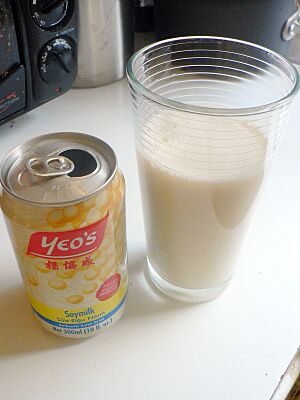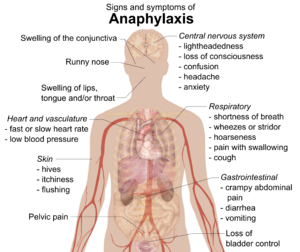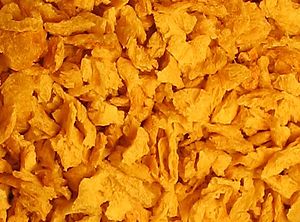Soy allergy facts for kids
Quick facts for kids Soy allergy |
|
|---|---|
 |
|
| Blocks of tofu, prepared by coagulating soy milk and then pressing to remove excess water |
Soy allergy is a type of food allergy. It happens when your body's immune system overreacts to things in soy (Glycine max). This overreaction can cause different physical signs.
Some common signs include tummy problems, trouble breathing, or skin rashes. Soy is one of the top eight foods that cause allergies in kids and adults. About 0.3% of people have a soy allergy.
Usually, people with soy allergy manage it by avoiding foods with soy. The most serious allergic reaction is called anaphylaxis. This is a medical emergency. It needs immediate help and treatment with a medicine called epinephrine.
Contents
What are the Signs of Soy Allergy?
Signs of soy allergy can appear quickly, from seconds to an hour. Or they can show up slowly, over several hours or even days. Some babies might get a soy allergy from soy-based infant formula.
Most children outgrow their soy allergy as they get older. But for some, it can last into adulthood.
Quick Reactions (IgE Allergy)
When you have a quick reaction, it's called an IgE allergy. Symptoms can include:
- Rashes or hives (itchy bumps).
- Itching around the mouth, lips, tongue, throat, eyes, or skin.
- Swelling of the lips, tongue, eyelids, or face.
- Difficulty swallowing.
- A runny or stuffy nose.
- A hoarse voice.
- Wheezing or shortness of breath.
- Diarrhea or tummy pain.
- Feeling dizzy or fainting.
- Feeling sick and throwing up.
Allergy symptoms are different for everyone. They can also change each time you have a reaction.
A serious danger happens if your breathing or blood flow is affected. Wheezing or a blocked airway means breathing trouble. A weak pulse or pale skin means blood flow issues. When these serious signs appear, it's called anaphylaxis.
Anaphylaxis happens when your body releases special antibodies called IgE. These antibodies cause a strong reaction in many parts of your body. If not treated, anaphylaxis can lead to a fast heartbeat, low blood pressure, and anaphylactic shock. This needs emergency help to prevent serious harm.
Slow Reactions (Non-IgE Allergy)
Non-IgE allergic reactions appear more slowly. They usually cause tummy problems. They don't typically cause skin rashes or breathing issues.
Some types of non-IgE reactions include:
- FPIES (Food Protein-Induced Enterocolitis Syndrome): This can be severe. It causes lots of vomiting 1-4 hours after eating the food. It can also cause watery or bloody diarrhea hours later. This can lead to dehydration.
- FPIAP (Food Protein-Induced Allergic Proctocolitis): This is a milder type. It causes occasional bloody stools.
- FPE (Food Protein-Induced Enteropathy): This causes long-lasting diarrhea. It gets better when the soy is removed from the diet.
Babies who react to soy formula might also react to cow's milk formula. There are guidelines to help diagnose and treat FPIES.
How Does Soy Allergy Happen?
Allergic reactions are when your immune system overreacts. It sees normal food parts, like proteins, as harmful. These food proteins are called allergens. They cause reactions even after food is cooked or digested.
Allergies are grouped by how the body reacts:
- IgE-mediated (classic): This is the most common type. It causes quick changes after eating. It can lead to anaphylaxis.
- Non-IgE mediated: This reaction doesn't involve IgE antibodies. It can happen hours or days after eating. This makes it harder to diagnose.
- Mixed IgE and non-IgE mediated: This is a mix of both types.
In a quick IgE reaction, special immune cells make IgE antibodies. These antibodies attach to other immune cells called mast cells. When the mast cells are activated, they release chemicals like histamine. These chemicals cause symptoms like a runny nose, itching, shortness of breath, or even anaphylaxis.
Later, other white blood cells can move to the reaction area. This can cause slow reactions like diarrhea or tummy upset.
Soy proteins that cause allergies have special names. For example, Gly m 1, Gly m 2, Gly m 4, Gly m 5, and Gly m 6 are some of them. Your immune system sees these proteins as harmful.
How is Soy Allergy Diagnosed?
To find out if someone has an IgE-mediated soy allergy, doctors look at their past reactions. They might do a skin prick test. This test puts a tiny bit of soy protein on the skin. They also measure soy-specific IgE in the blood.
A negative IgE test doesn't rule out a non-IgE allergy. These tests can sometimes miss an allergy or give a false positive. The best way to confirm an allergy is with a "food challenge." This is done by an allergy specialist. The person eats small amounts of soy under medical supervision.
For non-IgE allergies, there isn't a lab test. Doctors look at the person's symptoms. If the symptoms stop when soy is removed from the diet, then a diagnosis is made.
How is Soy Allergy Treated?
If someone with a soy allergy accidentally eats soy, the treatment depends on how sensitive they are. A doctor might prescribe an antihistamine like diphenhydramine (Benadryl). Sometimes, a medicine called prednisone is given to prevent a delayed reaction.
For severe reactions (anaphylaxis), treatment might include a bronchodilator (to help breathing) and an epinephrine pen. An epinephrine pen is a device that gives a shot of epinephrine. It's designed for people to use in an emergency. Sometimes, a second dose is needed.
Avoiding Soy Foods
If you have a confirmed soy allergy, you need to avoid foods with soy ingredients. In many countries, food labels must list soy as an allergen. Many fast-food restaurants use soy protein in buns or as meat substitutes.
Here are some common products that contain soy protein:
- Edamame (young soybeans in the pod)
- Hydrolyzed vegetable protein (HVP)
- Miso
- Nattō
- Okara (pulp from making soy milk and tofu)
- Soy sauce (shoyu sauce, tamari, teriyaki sauce)
- Soy (soy albumin, soy fiber, soy flour, soy grits, soy nuts, soy sprouts)
- Soybean (curd, granules)
- Soybean butter (like peanut butter)
- Soybean margarine
- Soy protein (concentrate, isolate)
- Soy milk
- Tempeh (fermented whole soybeans)
- Tofu (made from soy milk)
- Textured vegetable protein (used as a meat substitute)
Some food additives might also contain soy protein:
- Flavoring (natural and artificial)
- Prepared broths (chicken, vegetable, bouillon cubes)
- Vegetable gum
- Fruit wax (shiny coating on some fruits)
- Vegetable starch
- Mono- and diglyceride
- Monosodium glutamate (MSG)
Soy Products with Less Allergen Risk
Some soy products are less likely to cause a reaction. This is because they have very little soy protein. People with a mild allergy might not react to them.
- Highly refined soybean oil: This oil has almost no soy proteins. But avoid soybean oils made only by pressing.
- Soy lecithin: This comes from soybean oil and has very small amounts of soy protein. However, in the US, foods with soy lecithin usually still need to be labeled as containing soy.
Soy and Dairy Allergies
Some babies might have both a cow milk and soy protein allergy. This is called milk soy protein intolerance (MSPI). Some studies suggest that soy proteins from a nursing mother's diet might cause problems for her baby. However, more research is needed to confirm this.
About 10-14% of babies with a cow milk allergy might also be sensitive to soy. There's no medicine for MSPI. Instead, a breastfeeding mother can remove soy foods from her diet.
How Much Soy Can Someone Tolerate?
People with a mild soy allergy can often eat small amounts of soy protein. The amount needed to cause a strong reaction is much higher than for other food allergies. However, people with a severe soy allergy can react to tiny amounts, like in soy lecithin. They rarely go into anaphylactic shock unless they also have asthma or a peanut allergy.
Soy Allergy in Society
As more people know about food allergies, it affects families and caregivers. Soy is a common food additive. It's one of eight foods that must have warning labels. Schools often have rules about foods that can cause allergies.
Even with these rules, people with serious allergies know that accidental exposure can happen. This can cause "food fear," which affects their daily life. Children with allergies might also face Bullying from peers.
But most children who have a soy allergy when they are young will outgrow it.
Rules for Food Labels
Many countries have laws that make food companies clearly label if their products contain major allergens. This includes soy. However, most laws don't require labeling for tiny amounts of allergens from cross-contamination.
Ingredients Added on Purpose
In the United States, the Food Allergen Labeling and Consumer Protection Act of 2004 (FALCPA) requires labels to show if a packaged food has any of the eight most common food allergens. These include cow milk, peanuts, eggs, shellfish, fish, tree nuts, soy, and wheat.
If an ingredient comes from one of these allergens, the label must say its "food sourced name" in parentheses (like "Soy"). Or, there must be a separate statement like "Contains soy." The FDA advises people to always read the full ingredient list. The European Union also requires listing soy and other common allergens.
FALCPA applies to packaged foods. It does not apply to food made in restaurants. However, in the EU, restaurants must provide allergy information for unpackaged food.
Products Not Always Labeled
While many countries require allergen warnings on food labels, these rules might not apply to all items. This includes some medicines and cosmetics that contain soy. A person allergic to soy would likely not react unless they actually eat the allergen.
Trace Amounts from Cross-Contamination
Some labels might say "may contain" to warn about tiny amounts of allergens from cross-contamination during production. This is called Precautionary Allergen Labeling (PAL). These labels can sometimes be confusing. The EU is working on new rules for unintentional contamination. The US FDA also encourages companies to state possible cross-contamination on food labels using "may contain."
Genetically Modified Soybeans
Some people worry that GMO soybeans might cause new or more allergic reactions. But studies over 20 years show that the allergy-causing proteins in GMO soybeans are unchanged. This means GMO soybeans are safe and have low allergen risk, just like regular soybeans. Consuming GMO foods, including those from GMO soy, does not cause new allergies.
In 2018, a European Food Safety Authority panel found that a GMO soybean called Vistive Gold (MON 87751) did not have unusual allergen risks. Other organizations like the Food and Agriculture Organization of the United Nations and Health Canada also agreed that MON 87751 soybeans have low allergenicity.








